AMD's
most recent 45nm Athlon II processor just graduated from dual, to quad core. The
AMD Athlon II X4 620 is a
2.6 GHz socket AM3 chip destined for mainstream PCs; could it be the darling CPU
option for those on a budget? One thing's for certain, there couldn't be a better chip to
land in the midst of global belt-tightening, especially as the quad-core Athlon
II X4 620 retails for just $99 bucks.
There isn't another quad-core processor on the market offering so much value. Add to that mix the flexible AMD 785G platform which accommodates DDR2 or DDR3
memory, along with its fine-for-destop-applications-Radeon HD 4200 IGP and
you've got the building blocks for a truely inexpensive Windows 7 PC that can
hold its own.
The 95W TDP Athlon II X4 620 processor is
based on AMD's 'Propus' core which is architecturally identical to 'Deneb',
the backbone of the Phenom II. The difference is that 'Propus' lacks L3
cache while 'Deneb' has 6MB L3 cache. What the Athlon II X4 620 does have are
four independent processor cores each clocked at 2.6GHz with 512KB of speedy L2
cache (2MB total). The chip supports HyperTransport 3 at 4GHz, and can be installed into socket AM2+ and socket AM3 motherboards. The processor is manufactured on the 45nm SOI process at Global Foundries Fab 1 module 1 in Dresden, Germany.
Of course, a quad-core 2.6GHz chip without any L3 cache can't compete against AMD's Phenom II X4 965 BE or Intel's Core i7 920 processor. L3 cache has its advantages... For the price, the Athlon II X4 620 performs remarkably good in many benchmarks under Windows 7 and Windows Vista, as you'll see later in this review.
While it can be said that dual-core processors
improve desktop performance universally, four cores have typically been reserved for power users
who need parallel cores for video creation, 3D rendering, number
crunching and applications of the rendering sort. For standard office applications that support multi-core processors, a quad-core chip can help, but I think in this case one really needs to consider the entire AMD Athlon II X4 620 and AMD 785G motherboard platform as a whole instead of getting fixated on the number four. In the context of a Windows 7 PC that means DirectX 10.1 compliance, High Definition post processing (care of Radeon HD 4200 IGP) and a bit of a choice in DDR2 or DDR3 memory.
 |
|
|
AMD Athlon II X4 620 Processor |
|
|
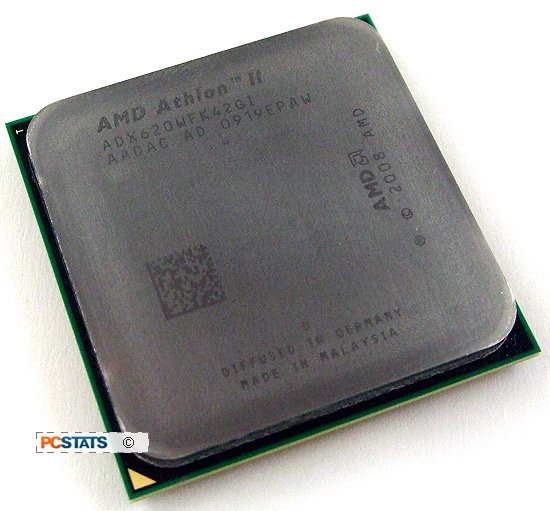 |
| Tech
Specs |
|
Athlon II X4 620
(quad
core)
Clock: 2.6GHz
L1: 256KB total
L2: 2MB
total
L3: none
Multiplier: 13.0x
Package:
938-pin
Socket: AM3 (AM2+)
organic mPGA
Core: 45nm
SOI
Transistor: ~300M
Power: 95W
Vcore:
0.85-1.425V
Cost: $99 USD |

| |
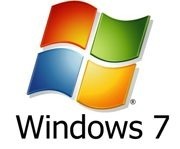 Like all of AMD's processors, the Athlon
II X4 620 has an on-board memory controller that can communicate with dual
channel DDR2 or DDR3 system memory at speeds of DDR2-1066 or DDR3-1333.
This also means the Athlon II X4 620 is natively a socket AM3 processor but
it can be installed into socket AM2+ motherboards without any problem (or at
worst a BIOS upgrade). It's this backwards compatibility that
continues to make the AMD platform a very cost-effective and easily upgraded PC. Like all of AMD's processors, the Athlon
II X4 620 has an on-board memory controller that can communicate with dual
channel DDR2 or DDR3 system memory at speeds of DDR2-1066 or DDR3-1333.
This also means the Athlon II X4 620 is natively a socket AM3 processor but
it can be installed into socket AM2+ motherboards without any problem (or at
worst a BIOS upgrade). It's this backwards compatibility that
continues to make the AMD platform a very cost-effective and easily upgraded PC.
The AMD
Athlon II processor and AMD's 785G chipset are both fully ready for Microsoft
Windows 7 operating system. In fact, the AMD 'Dragon' platform is positioning itself
as an economical mainstream solution for Windows 7 PCs. Windows 7 is moderately more demanding than Vista,
requiring at least a 1GHz processor, 1GB of memory and DirectX 9 compatible
graphics solution with WDDM 1.0.
As you would expect, the Athlon II X4 620 processor supports full hardware
virtualization, allowing a single core to run a copy of Windows XP inside of
Microsoft Windows 7. Virtualized Windows XP will be especially practical when it
comes to legacy software applications that don't run in Windows 7. The Athlon II
is also the first CPU to move C1E low power states out of the BIOS and onto the
CPU.
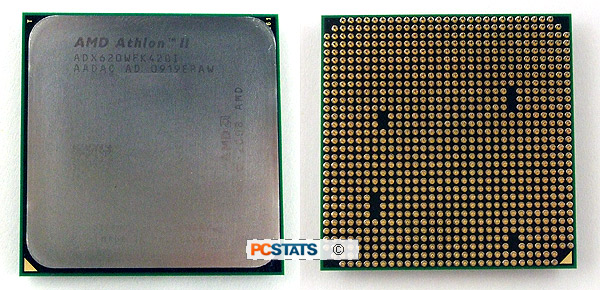
As the Athlon II X4 620 is priced at a mere $107 CDN ($99 USD, £60 GBP), there's
no way to get a quad-core processor for less money right now. This means its
closest priced competition will be coming from triple core processors like the
Phenom II X3 720, and some of Intel's Core 2 Duo
processors. Will the four cores of the Athlon II
X4 620 give it the performance edge needed to emerge at the top of the heap,
or will a lack of L3 cache cripple this processor?
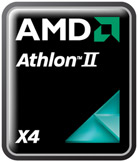 The Athlon II Quad-Core and AMD's "Propus"
die The Athlon II Quad-Core and AMD's "Propus"
die
The Athlon II X4 620 is built with AMD's "Propus" die,
essentially a slimmed-down version of the "Deneb" die that's been around since
first 45nm Phenom II processor. AMD's 'Propus' core consists of four individual
computational cores with 512KB of L2 cache each, but unlike "Deneb" it has no L3
cache. Consequently, the Athlon II X4 620 die is just 169mm2 in size, and
consists of a conservative ~300 million transistors.
Having no L3 cache has a few consequences for the Athlon II
X4 620 processor. A large, fast L3 cache is important for communication between
processor cores and multi-threading efficiency after all. When all four cores are busy processing threads, the L3
cache acts as a pool that feeds the individual L2 caches. Ultimately this
reduces the frequency that the processor has to fetch information from system
memory (your DDR2/DDR3 sticks) or virtual memory (your hard drive), both of
which are orders of magnitude slower than accessing on-die cache.
In applications that rely on streaming a lot of
data into all four cores (like WinRAR) from memory, the lack of L3
cache haunts the AMD Athlon II X4 620 processor like a lead brick. PCSTATS
will be testing this out a little later on in this article with
benchmarks that illustrate the point.
Removing the L3 cache also has the pleasant side effect of cutting the power
and heat produced by the Athlon II X4 620 down to around 95W, a significant
reduction from the Phenom II's 130W thermal envelope.
|
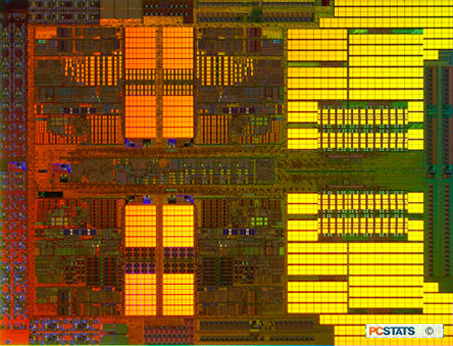
Above you can see the
AMD "Deneb" die that's used in processors like the AMD Phenom II X4 965
black Edition. The golden areas on the right are the L3 cache. 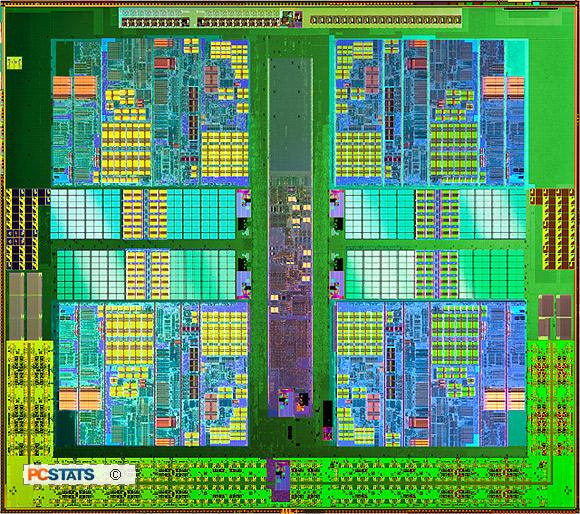
This is the Athlon II X4 620
"Propus" die. The L3 cache has been removed, cutting down die size and
reducing the processors power requirements and heat output.
|
While AMD has assured that all Athlon II X4 620 processors are based
on this new "Propus" die, the company has stated that certain AMD
Athlon II X4 630 processors are still based on the "Deneb" die, and simply
have disabled L3 cache.
|
AMD Athlon
II / 64 Processors |
|
Processor Models |
Thermal Design
Power |
Clock
Speed |
Cache |
Price (CDN) |
|
AMD Ahtlon II X4
630 |
95W |
2.8 GHz |
2MB (4 x 512 L2) |
$132 |
|
AMD Ahtlon II X4
620 |
95W |
2.6 GHz |
2MB (4 x 512 L2) |
$107 |
|
AMD Ahtlon II X2 250 |
65W |
3.0 GHz |
2MB (2 x 1MB L2) |
$96 |
|
AMD Athlon 64 X2 6000 |
89W |
3.1 GHz |
1MB (2 x 512 L2) |
$90 |
|
AMD Athlon 64 X2
7850 |
95W |
2.8 GHz |
3MB (1MB L2+ 2MB L3) |
$84 |
|
AMD Athlon X2 7750 |
95W |
2.7 GHz |
3MB (1MB L2 + 2MB L3) |
$72 |
|
AMD Athlon 64 X2 5200 |
65W |
2.7 GHz |
1MB (2 x 512 L2) |
$69 |
|
AMD Athlon 64 X2 5000 |
65W |
2.6 GHz |
1MB (2 x 512 L2) |
$64 |
Looking at
the current line up of AMD Athlon II processors reveals a trend in pricing that
anyone on a budget will appreciate. The Athlon II X4 620 is ~$10
more than the Athlon II X2
250, and both processors are compatible with a huge range of socket AM2,
AM2+ and AM3 motherboards. While PCSTATS is still expecting the faster-clocks of the AMD Athlon II X2 250 processor to
give it a bit of a lead in single-threaded applications, how the extra cores of
the Athlon II X4 620 will offset its lack of L3 cache is the
question of the day.
Moving on,
the power meter is hooked up and ready to measure,
so let's take a look at how much juice a PC system built with a quad-core Athlon
II processor actually draws.
|

